Morgan Super 3 | In-depth
[A more in depth description of the new Morgan Three Wheeler. First Morgan with a Cup Holder? Enjoy, Mark]
Posts specific to information relating to the Morgan Sports Car
[A more in depth description of the new Morgan Three Wheeler. First Morgan with a Cup Holder? Enjoy, Mark]
[Well, here it is! The long-awaited announcement of the new Morgan Three Wheeler. Lots of things to see here. The most obvious is that the upfront S&S V Twin is gone, replaced by an enclosed engine from Ford. That, and lots of other things. Look closely!! Enjoy, Mark]
[A new Morgan LM 62 owner picks up his car at the revamped London Morgan dealership. Mark]
[Thanks to MOGSouth member Bennett Shuldman for alerting me to this video. Mark]
Per the MMC – ‘For the first time ever, a drone has taken flight around the historic home of Morgan at Pickersleigh Road. The 108-year-old factory – which welcomes around 30,000 visitors each year – is famed for being home to the production of the Morgan Plus Four and Plus Six, and will shortly be the site where the company’s all-new three-wheeled model will be produced. Viewers are transported in a one-take shot of the production line, moving through the Chassis, Assembly, Sheet Metal, Wood, Trim, Final Finish and Paint shops, before finishing in the Pre-Delivery Inspection department. Eagle-eyed viewers will spot a special project or two, watch the video to identify the special project cars for yourself.’
WILL BE UNVEILED ON 24 FEBRUARY 2022
Following the end of production for the Morgan 3 Wheeler, the Morgan Motor Company is delighted to confirm that an all-new three-wheeled model is undergoing testing ahead of its launch on the 24 February 22.
Morgan have published images of a heavily disguised engineering prototype, a montage of early design sketches and one of the images from the pre-launch film and photo shoots.
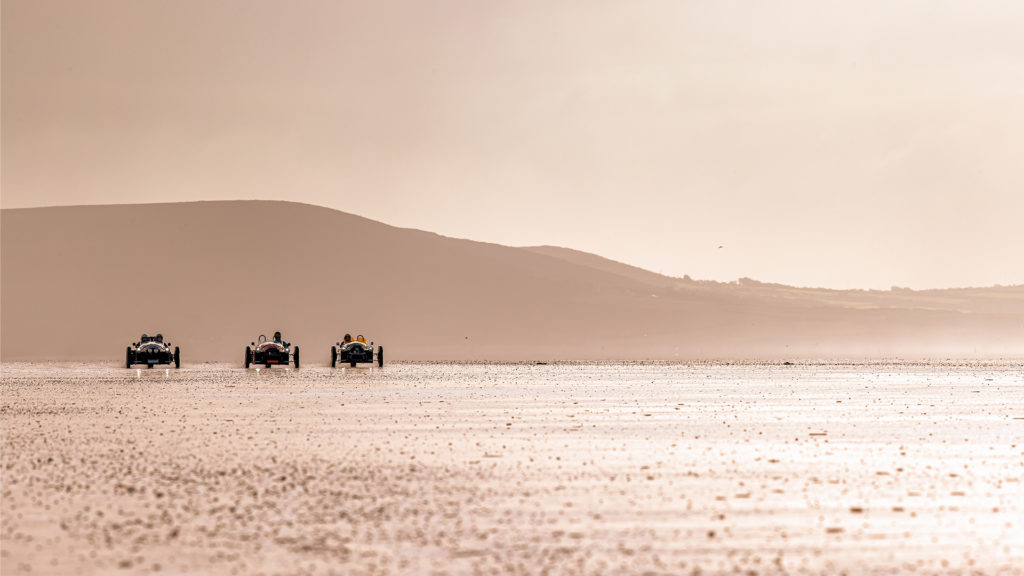
Most details, including the name, will remain undisclosed until the global unveil on 24 February. But Morgan has confirmed the use of a Ford three-cylinder engine for the upcoming model, continuing the long-standing use of Ford powerplants in the company’s line-up.
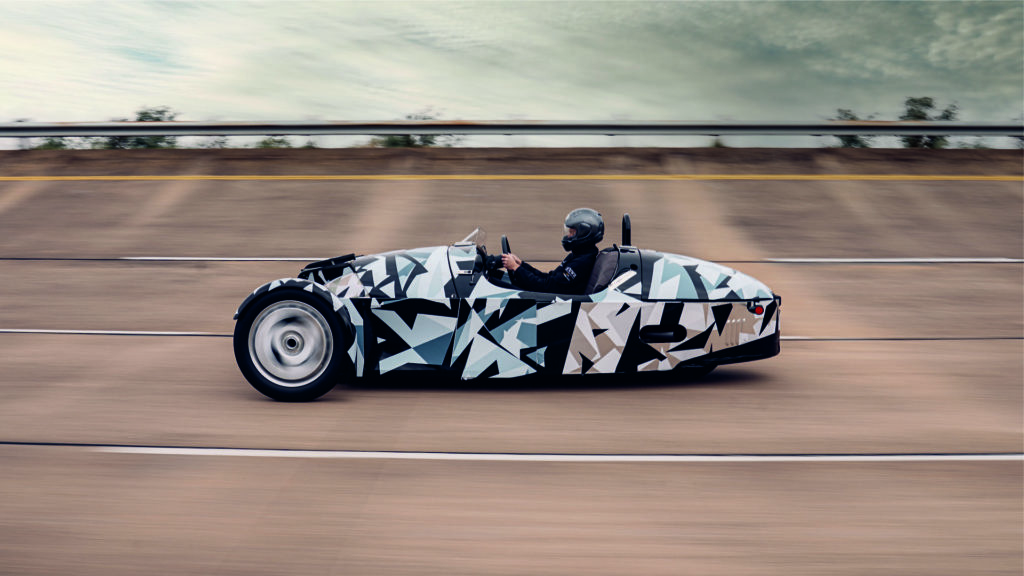
The illustrations shared by Morgan show that the design of the new model is bold and eccentric, taking inspiration from mid-century jet planes, motorcycles, historic Morgan models and modern industrial product design — images of which adorn the walls of Morgan’s design and engineering offices.
Complementing this personality will be an extensive list of specification items and accessories available from the outset, making it Morgan’s most configurable vehicle ever. The model can be tailored to assume multiple identities, and cater for every adventure.
Intrigued? You can be one of the first to own the all-new model. Our dealer network is taking deposits now for the first customer build slots. Complete the form below to contact a dealer and find out more.
Five decades separate a pair of British sports cars with a very similar vibe.. Time to see what else splits them.

Very funny. But I’ll concede that getting these two Morgans together is a very visual demonstration of both the company’s design language and its evolutionary philosophy. A number plate swap might just prove enough to divert your attention from the 56-year age gap between these cars. Yep, one of them really is as old as the England mens’ last major football success.
Photography: Jonny Fleetwood
With thanks to Chris Towner for the loan of his delightful Morgan 4/4
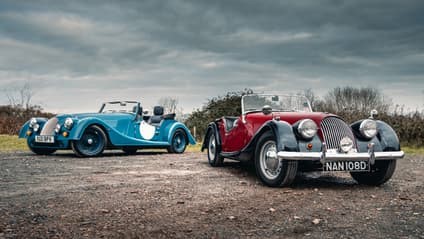
Back in the Sixties, exterior door handles were on the Morgan options list. And the 4/4 you see here is in ‘purists’ spec’ – aka it doesn’t have any. It’s best to keep the roof down at all times if you want to get into the car without looking like you’re breaking into it. Other differences involve a different layout of spotlights up front and a disparity in their number of hand-stamped bonnet vents; both cars sport eight each side, but the older car doesn’t require a stip of them on top.

Correct. In wonderfully period red ‘n’ black is a Sixties Morgan 4/4, with a 1.6-litre 4cyl Ford engine sending a supremely modest 75bhp and 98lb ft to the rear wheels via a four-speed gearbox. One which sees the shift lever emerge from under the dashboard; while its H-pattern is familiar, actually getting adept with it takes a minute. In blue is a brand-new Plus Four, a 2.0-litre 4cyl BMW turbo providing the rear axle – and much better tyres, I might add – with 255bhp and 258lb ft via a six-speed manual sporting an unglamorous knob but a slick, easy shift.
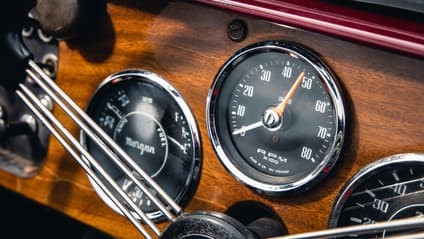
With more than three times the power, the Plus Four is unquestionably a quicker car. But these things are all relative. The 4/4 carries barely more than half its newer relation’s weight, at 660kg, and with skinnier tyres and a surprisingly torquey old engine, it moves more than swiftly enough. On grimy roads you might find yourself managing the Four’s turbocharged delivery a bit, whereas the 4/4 gives you everything with zero drama, revving keenly around its quaint dial but delivering so much below 4,000rpm that you can exercise mechanical sympathy without stymying your pace.
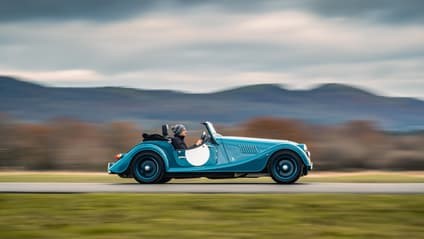
As well as smelling like it was made in the Sixties, the 4/4 brakes and steers like it, too. Halting for a roundabout needs forward thinking and the wheel is overly large. But it twirls around without much resistance and given how measured the game little Ford engine is in its delivery, you can drive this thing with vigour and trust implicitly in the chassis below taking the strain. Despite the Plus Four’s heap of extra performance – a 5.2-second 0-62mph time is probably about half its ancestor’s – the same is true in the ’22 car. ABS helps it stop keenly, too.
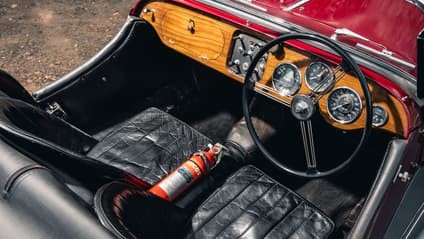
There’s less of a gap between them than I’d anticipated. I recently ran a Plus Four for 12 months and happily declared it a “a modern Morgan”, and yet with a bit of context the experience it delivers is astonishingly faithful to a car five decades its senior. Beyond the 4/4’s wing mirrors actually being on the wings, its glovebox locking like a Victorian dresser drawer and its lack of head rest or three-point seatbelt, the interior ambience and view up the road is all but the same as the Plus Four’s.
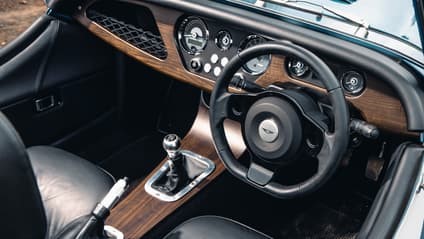
The newer car’s tech – Bluetooth audio, air con, heated seats, power steering, ABS – largely operates in the ether and doesn’t have overt visual cues. And with the side screens removed – the most authentic way to drive a Morgan – these two deliver an identical level of refinement and sense of safety on a 60mph country road. Which suggests Morgan makes the most tactful progress of any carmaker, keeping its models’ core attributes wholly intact while integrating the tech we all secretly want with real subtlety. What ho!
[An interesting write up but rumor has it the CX Plus 6 will come to the US before the CX Plus 4. Mark]
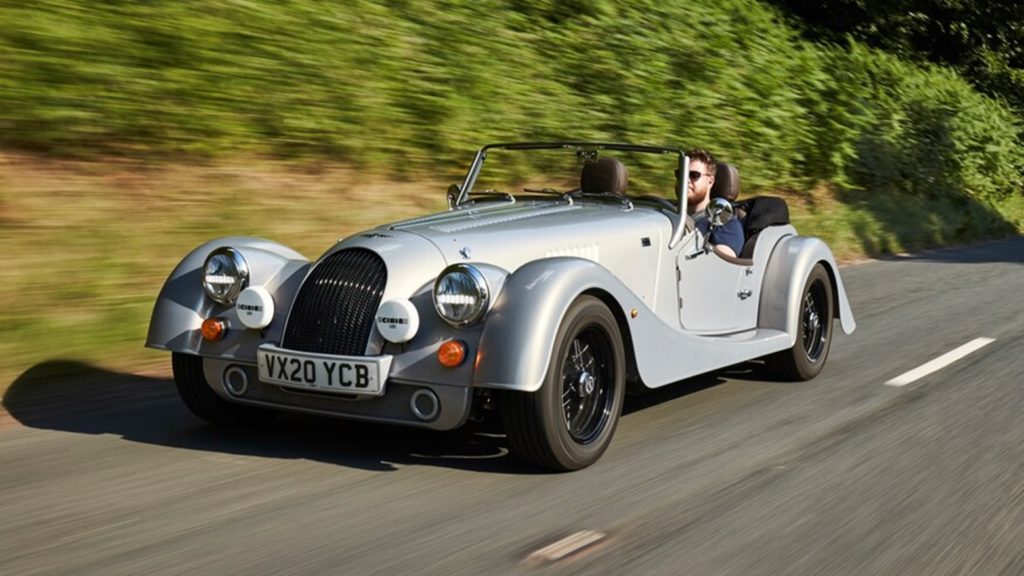
It’s been almost 34 years since I first drove a Morgan. Not much has changed. And yet, everything has changed. At first glance, the 2022 Morgan Plus Four looks almost exactly like the French Racing Blue Morgan 4/4 I tested back in 1988: same long, center-hinged hood with louvers on the top and sides, same flat windshield with three tiny wipers, same sweeping fenders, same cutaway doors, same grille.
But more than 97 percent of its parts and components are different. This 21st-century Morgan drives very differently, too.
Morgan Motor Company was founded in 1909 by Henry Frederick Stanley Morgan and has been subsequently run by his son, Peter, and grandson, Charles. The family still has an interest in the company, but since early 2019 Morgan has been majority owned by Investindustrial, a private equity firm founded by Italian businessman Andrea Bonomi.
Morgan cars are still hand-built in the quaint red-brick factory on Pickersleigh Road in Malvern Link, England, established by the company more than 100 years ago. And for most of those 100 years, the cars built there have changed little: The previous-generation Plus Four was built on a ladder frame steel chassis whose basic design dated back to 1936 and whose sliding-pillar front suspension had been a feature of almost every Morgan built since 1910.
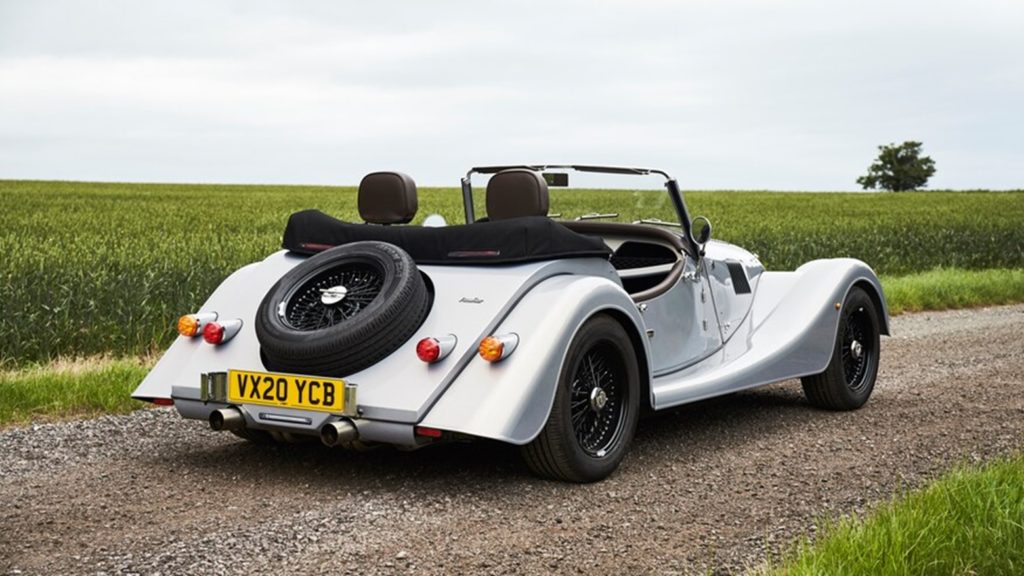
The 2022 Plus Four is built on the all-new CX bonded aluminum chassis developed in-house at Morgan that made its debut under the new Plus Six (see sidebar) unveiled at the 2019 Geneva Show. The CX chassis is 100 percent stiffer than the old steel one and has modern multilink independent suspension front and rear. There’s still wood in the 2022 Plus Four’s structure, though: The hand-formed aluminum body panels are fixed to an ash frame that sits over the chassis, just as they always have been in Morgans.
The Plus Four comes standard with a 15-inch alloy wheel, the design of which has a faintly ’60s/’70s vibe; it can be ordered with classic wire wheels in silver, black, or polished chrome. The wire wheels are proper center-lock items that fit over splined axles, which means cars ordered this way are literally specially built from the wheels up. The Plus Four’s four-wheel disc brakes are mounted further inboard than is normal modern practice to allow for the fitment of the wires, which have a very different offset from modern wheels.
The juxtaposition between tradition and technology is more clearly evident in the Plus Four’s cockpit.
Although it’s slightly roomier than the old car’s interior, and the 2022 model year cars get new seats that include adjustable lumbar support, the view through the flat windshield is little different from that from the driver’s seat of any four-cylinder Morgan roadster built since 1936. But the three-spoke steering wheel is a rather charmless, plasticky-looking thing, and the vaguely rhomboidal BMW shifter sticking out of the center console in automatic transmission cars looks as incongruous as the monolith in 2001: A Space Odyssey.
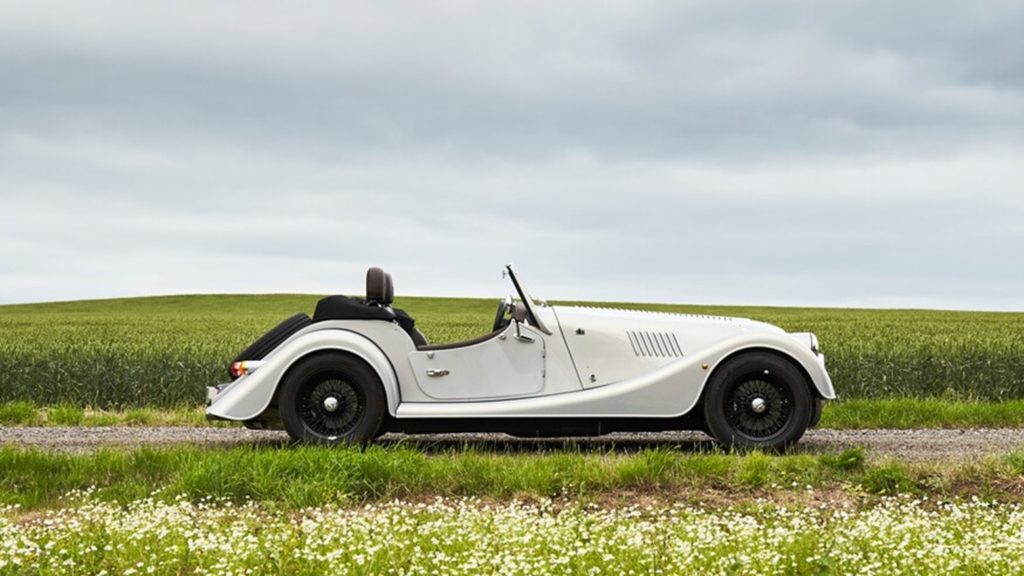
Other updates for the 2022 model year cars include an all-new soft top. No more stretching cloth and wrestling with rows of dot fasteners: The front of the soft top is snugged down by two toggle latches that hook into slots at the top corners of the windshield, while two catches, activated by a door handle lever mounted beside the driver’s seat, cinch the rear of the hood into place. It’s still a bit like assembling a tent compared with raising a Mazda Miata MX-5 soft-top, but it’s a lot easier than it used to be.
Morgan has never made its own engines: “That’s not what we do,” Morgan design chief Jonathan Wells said. Morgans have been powered by everything from V-twin motorcycle engines to lusty Rover V-8s over the decades, but the Plus Four’s ancestors were predominantly Ford-powered. The 4/4 I tested in 1988 had the unremarkable 1.6-liter Ford CHV four-banger that saw duty in the front-drive Escort in the U.S. under the hood. It wheezed out just 95 hp at 6,000 rpm and 99 lb-ft of torque at 4,000 rpm, driving through a five-speed manual.
Fortunately, the 4/4 weighed a mere 1,620 pounds, so it could at least get out of its own way.
The 2022 Plus Four has BMW’s tasty B48 2.0-liter turbocharged four—the same engine that powers the entry-level BMW Z4—under its long, louvered hood, driving through either a six-speed manual or an eight-speed automatic transmission. Order the manual, and you’ll get 255 hp and 258 lb-ft of torque. Order the auto, and you still get 255 hp, but the torque jumps to 295 lb-ft. That’s quite a step up from that old 4/4—two-and-a-half times the power and two-and-a-half to nearly three times torque. Especially when you consider the 2022 Plus Four weighs just 40 percent more.
I’d sampled the regular Plus Four in manual trim while waiting to drive the riotously steampunk Plus Four CXT “adventure roadster. ” But Morgan insiders insisted the Plus Four automatic was the better car. And after a couple of hundred miles on quiet back roads in southern England in the eight-speeder, I’d have to agree, not the least because without a clutch pedal taking up room in the narrow footwell, there’s somewhere to rest your left foot. The manual Plus Four is a visceral and slightly challenging drive; the automatic overlays that quirky character with a level of performance that will make you laugh out loud every time you punch the gas pedal.
Consider: Morgan claims the manual Plus Four will sprint from 0 to 60 mph in about 5.1 seconds on the way to a top speed of 149 mph. The automatic is no faster at the top end. But it’s four tenths of a second quicker to 60. It might look like it’s driven straight out of the 1930s, but the Morgan Plus Four automatic will give a base 300-hp, 280-lb-ft, PDK-equipped Porsche 718 Boxster a run for its money. At least until that square-rigged bodywork hits the aerodynamic brick wall.
Those raw numbers don’t tell the full story, though. On the road, with the powertrain switched to Sport + mode and using the fixed paddles behind the steering wheel to shift manually, the Plus Four feels almost supercar quick, especially from 45 mph to 100 mph.
It’s not just that at 9.0 pounds per horsepower the Morgan’s weight-to-power ratio is almost 13 percent better than that of the entry-level Boxster; the BMW engine’s meaty midrange thrust—all 295 lb-ft is on tap from 1,550 rpm through 4,400 rpm—punts the Plus Four hard out of corners and effortlessly gets it past slow-moving traffic on short straights. Torquey-quick and compact—it’s more than 20 inches shorter and 5.0 inches narrower than a 718 Boxster—this Morgan is exhilaratingly rapid on narrow, winding two-lane roads.
The 2022 Plus Four has power steering that’s light and accurate, if not overly communicative. It has antilock brakes, too, but because the car is so light, you rarely get near the intervention threshold. Standard tires are Avon ZV7s in a generously side walled old-school 205/60 R15 format.
With the powertrain in the Comfort mode the Plus Four will happily mooch around at low speeds, the eight-speed automatic defaulting to the highest gear possible as soon as possible—on a light throttle it’s in third gear by 15 mph and sixth by 30 mph—to improve fuel economy. As in any BMW, flicking the shift lever sideways engages Sport mode. Sport + is activated via a button on the center console.
The Plus Four likes to be braked early—the pedal on our test car was a little softer than we’d like—turned in early and have the power fed in early. There’s no traction or stability control, and that, combined with the stiff, relatively short travel suspension and the BMW engine’s insistent torque, means the Morgan can feel a little skittish if the road surface is greasy and lumpy and you’re too eager with your right foot.
Although it can feel very busy through its vertical axis even on straight, rough roads, the Morgan tracks true, unlike that old 4/4, which I remember bouncing and bucking like a runaway Conestoga wagon. And the yaw motions in corners feel relatively relaxed once your backside is calibrated to the fact it’s sitting barely a foot in front of the rear axle, and about six feet behind the front.
The biggest key to getting the most out of this car is figuring out what’s happening way up there at the front axle and learning to compensate accordingly to get the Plus Four to change direction when you want it to. It can be challenging to hustle hard, but only in the sense that you must understand its nuances and drive it accordingly. The Morgan Plus Four is a driver’s car, in the truest sense of the term.
It’s not a freeway cruiser. Although the Plus Four will roll along effortlessly at 80 mph, the engine turning barely 2,000 rpm in eighth gear, the wind roar past that flat windshield and over that unlined soft top is deafening, and a rush of air will blast through the rudimentary door seals, even with the roof raised. If it’s cold out, your shoulder and leg will soon be frozen.
The gas tank holds just over 12 gallons, enough, based on the 26 mpg the Plus Four averaged over 200 hard-driven miles, for more than 300 miles of driving range. That’s plenty. You’ll want to stop for a coffee before then.
On any other road, whether you’re just bowling along or pressing on, almost every mile in the Morgan Plus Four will make you smile. It’s quirky and charismatic yet oddly endearing and deeply engaging, the complete antithesis of many of today’s sanitized and smirkingly competent sports cars. The Morgan Plus is perfect for when you have nowhere to go and all day to get there. And if it’s cold outside, rug up, crank the heater, and drop the roof anyway.
That’s what driving a Morgan is all about.
What About The Morgan Plus Six?
Think of it as Morgan’s Cobra—that’s the Morgan Plus Six I also drove, in a nutshell.
The rear wheels kept spinning even as the eight-speed auto slipped into fourth gear. Acrid smoke swirled into the open cockpit, obscuring the view ahead. I lifted off and looked back. The quiet English lane had disappeared, a thick white-blue cloud hanging between the hedgerows. I’ve smoked the tires on everything from Corvettes to Bentleys. But the 2022 Morgan Plus Six might be the best burnout car I’ve ever driven.
When Carroll Shelby hit on the idea of replacing the 2.0-liter four-cylinder engine that powered the AC Ace roadster with the 289 Ford V-8 to create the original Cobra, other British sports car makers took notice. Sunbeam shoehorned a 260-cubic-inch Ford V-8 into the engine bay of its Alpine roadster to create the Tiger. In 1973, MGB offered its GT Coupé with V-8 power.
Even tiny Morgan decided to get in on the act in 1967, launching the Plus Eight, a reworked version of its long-running Plus Four with Rover’s Buick-based 3.5-liter V-8 under the hood. That Plus Eight, which in the 1960s was Britain’s fastest-accelerating car, stayed in production until Rover stopped building the V-8 in 2004. A new Plus Eight, powered by BMW’s 4.8-liter V-8, appeared in 2012.
The Plus Six is the CX-based successor to those cars. And, true to tradition, it’s hella quick. Quicker than any of them, in fact.
Under the hood is BMW’s 335-hp, 369-lb-ft B58 turbocharged inline-six. The only transmission available is an eight-speed automatic. The all-aluminum CX chassis is the same as that of the Plus Four, but the Plus Six’s track is 4.1 inches wider, courtesy of longer suspension arms front and rear, and it rolls on wider 18- or 19-inch alloy wheels shod with low-profile tires—Continental Sport Contact 6s, 225/35 ZR19 up front and 245/35 ZR19 on our test car.
In simple terms, the Plus Six has nearly 30 percent more power and 25 percent more torque than the Plus Four, but it only weighs 6.5 percent more. Morgan says it’ll get from 0 to 60 mph in about 4.0 seconds. Claimed top speed is 166 mph. And it feels every bit that fast.
It’s a much more immediate car than the Plus Four, in every way. The wider track and lower-profile tires, along with spring rates that are 100 percent stiffer at the front and 16 percent stiffer at the rear, sharpen the dynamic responses, though, curiously, the ride doesn’t feel noticeably worse than in the Plus Four. And with so little weight to move, the BMW six feels as if it’s always on.
That immediacy—and that fact that it also doesn’t have traction or stability control—makes the Plus Six a vintage-style roadster with a similar power-to-weight ratio as a Z51 C8 Corvette Stingray, a car that must be treated with respect. Get sloppy or careless with your right foot, and it will bite you.
A bit like the original Cobra, then…
I just found this short video and it is interesting, if not somewhat bitter-sweeet, specially now given the recent spy photos and leaked technical tidbits about the ‘new’ M3W. Rumors have it that there may be some real information about the new model coming before the end of the year! Enjoy, Mark